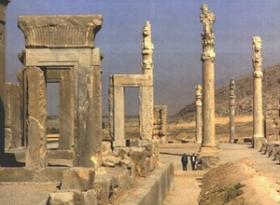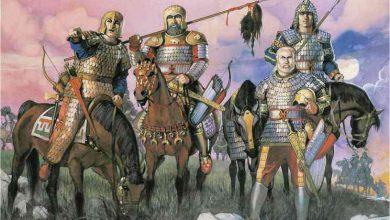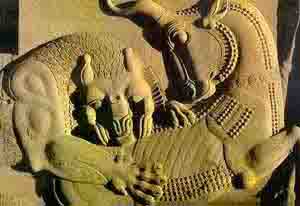Masonry and designs of Persepolis

Highlights that The palaces of Persepolis Is one of the most important antiquities that has survived to this day. The quality and quantity of these works is such that it requires extensive studies, but to date no valid stylistic analysis has been published. Be not done on them. The present study tries to fill the existing gap according to the different aspects of styles and methods, from the methods used in engraving to design principles, from identifying the work of sculptors, to describing the progress of the time sequence of the "Persepolis" style..
The morphology and different types of influence of external factors, which have been the subject of many studies, will not be discussed..
The first medicine (486-552 BC) Created the design of the main palaces of Persepolis and his tomb and Naqsh-e Rostam. Construction work during the reign of his son Xerxes I. (۴65–486 BC) And his grandson Ardashir I. (۴25-۴/۴65 BC) It continued, but regardless of some changes and renovations of buildings during the reign of Ardashir III (338-8/359 BC) Other Achaemenid kings, although they built their tombs in Naqsh-e Rostam overlooking the Persepolis plateau, did not build any buildings on the plateau. Remained unchanged.
The area of Persepolis Palace is divided into three parts: class surface (Persepolis) On which the main buildings are located, the buildings located in the plain to the south and west of the plateau and finally the slope of a high hill to the east of the plateau, about twelve buildings were built on the plateau and most of them were decorated with reliefs. Which were carved on the entrances, stairs and door and window frames. The main background of these motifs shows the glorification of the Persian kings, which is significant in the scenes. Now the king is either walking and passing through the doors of his palace or sitting on the throne and accepting gifts from the people under his command..
The healthiest reliefs are those on the east side of Apadana, on the steps of the main building, both of which are preserved under the rubble of collapsed brick walls.. Apadana reliefs generally depict the king sitting on a throne, while in front of him twenty-three delegations of people under the government are presenting valuable and extraordinary gifts, and behind the king are rows of guards, horses, chariots, and courtiers. have became. A large number of Persian soldiers are lined up on the steps and sidewalks. In total, more than 800 carvings have been carved on the eastern front of Apadana. The same scene, which is inverted, can be seen on the northern front, but has been badly worn because it has been exposed to weather for centuries.. On the northern steps of the central building, the guards are seen to be of normal human height, while court aristocrats in Persian or material clothes are climbing the stairs, and in those benches the ranks of the Persian soldiers are stationed.. There are about 400 reliefs here. In the outer part of the southern stairs of the same building of the Persian archers, and in the inner part, the servants can be seen in Persian and material cover. Darius and the palace of Ardashir I are decorated with motifs of delegations of nations and employees. However, these reliefs have been damaged by human and atmospheric effects.
On the door frame of Darius's palace, Xerxes's palace, the shrine and the central building of the king can be seen under a canopy that is accompanied by court servants. On the other thresholds of the doors is a royal hero in battle with a legendary beast of war, or the king sits on his throne and the throne is on a platform that the people of the empire do instead of the people..
Although the designs are many, they are remarkably similar. Single statues are repeated several hundred times in the same position, not once or twice, but while soldiers line up on the steps and railings.. The variety of scenes is small, and many of them are repeated in the same way. The same face design is shown for Persians, Medes and most aliens.. Parsa, without exception, long clothes (Reply) The pleats are worn, and these garments are shown in a limited number of different roles, while the females are all clothed in sleeveless clothes that reach up to their knees.. This similarity seems to make the engraving of the motifs much simpler and more mechanical, and the amount of different shapes and scenarios used in Persepolis is insignificant compared to the total number of motifs..
More than 3,000 engravings have been created on the buildings and tombs of Persepolis. There are few motifs in other Achaemenid buildings. 32 roles in Pasargadae, 14 roles in Biston, 8 roles in the Egyptian Stone Column Canal built by Darius I, and a small number in Darshush, Babylon and Tal Hakvan. Even if it is possible that more of these motifs have been lost, it cannot be imagined that there was a considerable sculpture and sculpture industry in Persia before the construction of Persepolis..
Persepolis reliefs have been known in Europe since the seventeenth century. In the 1930s, the American delegation, led first by Ernest Hertzfeld and then by Eric Schmidt, discovered many sculptures, including the east façade of the Apadana, the two steps of the central building, and the orthostatus, which was transferred to the treasury.. These discoveries doubled the number of known reliefs in Persepolis, and since they are in almost perfect condition, they should be the basis of any study to identify the style of Persepolis reliefs.. The results of the American delegation's excavations were published in three very interesting volumes of books, which include extensive cases of all the buildings on the plate.. But in spite of the fact that the book of Persepolis Schmidt is extraordinary in all respects, it is clear that when he explains the reliefs, he has only examined them from photographs.. This means that he has ignored some principles, such as sculptural signs, and this is where his citations are inadequate.. Recently, many efforts have been made by Mr. and Mrs. Tilia. These studies were based on the precise reconstruction work in Persepolis, the reconstruction work continued from 1965 to 1979 under their responsibility..
Tools:
Achaemenid masonry has been studied in detail by Brittelia and Carl Nylander. Here I am only discussing working on reliefs. Engraving techniques can best be seen on unfinished parts of reliefs, and almost any stage of the work can be identified somewhere in Persepolis.. In some cases, we can determine from the markings left on the stone what tool is used and in what order.. Iron tools, whether pickaxes and hammers (With horizontal handle) Or a sharp pen and a chisel (Which is hit with a wooden mallet) Was used.
Each of these two groups can be divided into sharp, edged and toothed tools of any size and weight.. The heavy pickaxe was used for masonry and initial shaping, depending on the size of the piece of stone to be removed, with a vertical blow, with a quick blow and a breaker.. The next step was probably to use flat pens and wooden hammers. To prepare a smooth surface, a sharp-edged hammer is usually used, and more generally, and perhaps over time, a toothed hammer.. Subsequently, finer hammers have been used in conjunction with edged pens.. Slim flat-edged pens and chisels were used in detail.. The last step was to smooth the surfaces with abrasives of varying degrees and water, and finally to remove the remaining scratches, abrasion was applied by rubbing the stone with the same degree of hardness or lead or leather that was probably the shark skin, followed by embossed colors. Were.
In this brief, the tools and how to use them are briefly stated, but here I must point out that at any stage of the sculpture or building could benefit from different types of tools: Depending on his personal training and inference, as well as the importance of what he was doing, he used a pen with a pickaxe, edged or serrated tool. A sharp-edged hammer with a flat seam is difficult with a serrated hammer with a serrated chisel..
There is no evidence for the use of round or cavernous saws, saws, flat racks or racks. Small holes were made by drilling to attach metal ornaments and pipes to pour molten lead, possibly arched drills using short, abrasive heads but by ((Rotating drill)) Which was widely used in the Greek sculpture industry, has not been used. Turning is not used in stone architecture, but it is used in wood, metalwork, and for the industry of making stone utensils and cylindrical seals..
There is no sign of other tools used by sculptors and builders. One of these tools is the building block, which consists of a flat edge, a right angle, a level and a plumb line.. Gonia and alignment can be separated, and perhaps this is why some buildings have their characteristic mark for level A and for gonia….. They choose. In addition, cotton gauges, wooden rulers, and splitters have been used to draw circles, strings, and colors.. It is possible that prefabricated wooden stencils were used to inspect and inspect the molds and perhaps to carve embossments..
Painting and decoration
When Herzfeld excavated the reliefs of Apadana and the central building, he found many traces of the colors he had attached to them, but unfortunately did not record much detail.. Today, traces of those colors still remain, especially on the reliefs of the Hundredstone Hall, where the role of Ahura Mazda and the seats of the royal throne have retained their original color.. Elsewhere, red on some of the lips, nostrils, and eyes of the Persian guards on the covered porch of the central building, on the mouth and nostrils of the capitals, on the nostrils of the heroes in the Apadana reliefs, and on the king's door on the doors of the central building. There is. Various elements are painted in a uniform shade of red, green, blue, and possibly yellow; other colors, such as black, made from soot, may have been consumed but left no trace.. To help the painter with the painting, they sometimes create ideas on the surface of the stone by scratching.. Lions, signs on the arm and floral and plant designs have been seen on the clothes in Darius's palace, Xerxes's palace, the central building and the interior. And the glory and color are bright and clear, and its dimensions and size are distinguished from others.
During the remainder of this category, the reader should keep in mind that many of the details that have already been revealed have disappeared under the color.. Especially the unfinished parts were all painted. It does not matter to what extent the patterns are painted. For example, we do not know whether the skins of the statues were painted or not, or what color was used to paint the soldiers' uniforms.. It is not true that the surface of the stones was intentionally laid unevenly to absorb the color better, and in fact it was naturally the smoother parts on which the color was preserved..
Some of the relief carvings and the tops of the columns are decorated with colored stones or metal or decorated with gold leaf and foil.. On the statue of the king in the palace of Darius, the palace of Xerxes and the central building has a crown and some jewels in stone, it is thought that the necklaces, patterns and crowns are made of precious metals and stones.. Sometimes the beards, too, may have been carved with Egyptian blue stone. In Palace P in Pasargadae, holes can be seen in the king's shoes or clothes, which were used for decorations..
Duration of creating patterns
It is difficult to estimate the time it takes to engrave a single role. The duration of this time depends on many factors, the artist's skill and experience, the quality of supervision, the division of labor between the sculptors, as well as the type of relief carving and the characteristics of the stone.. In view of these uncertainties, it may even seem anomalous to suggest an estimated duration, but the point is so interesting that any estimate, however approximate, is worth noting..
As it has been determined from the study of the ossuaries on the balcony of Apadana, because the different parts of the maps were probably engraved by different sculptors, the minimum time required to complete the role was some time when the details of the head were engraved.. If one knows this time and also has the number of sculptors who were experts in engraving on the head, one can calculate the time of engraving an overview. As an approximate estimate, it took between three and six days to carve the head of one of the smallest carvings, and at least twice as much time was spent carving the head of one of the largest figures.. The three masters of the masonry spent three months completing an Apadana pillar, after which the stone was cut and transported to the site.. Given these figures, the above estimate may be very small. In the fourth season, we will see that two teams of sculptors worked on the northern front of the eastern side of Apadana, where there are 242 small archers and guards and 136 spearmen, nobles and middle-class aristocrats. There were a number of sculptors in each team. But on the whole, in each team, one or two carvings have been engraved on the heads of the roles. It took at least twelve months to carve this view, but it probably took two or three times as long..
Click on the link below to download the book of Persepolis designs






